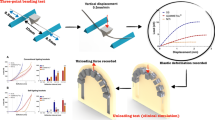Abstract
Since 1994, the DIN (Deutsches Institut für Normung e.V.) has had a German working group named “Orthodontic Products” working toward establishing standardized norms for orthodontic products. In the USA, a similar working group called “Orthodontic Materials” was established in 1996 at the ADA (American Dental Association). Working at the ISO level since 1997, an international team has been in charge of unifying the standards already set at national levels.
It is the aim of this article to report on the current state of standardization in Germany and internationally. The standards already published for wires (DIN 13971, ADA Spec. 32), for brackets and tubes (DIN 13971-2, ADA Spec. 100) and for elastomeric elements (DIN 13901) have been considered, as have problems occurring with ISO standards (ISO/CD 15841 and ISO/CD 15841-2) and DIN 13904-1. We demonstrate that the demands made of these products by the orthodontists who use them have lead to reasonable quality standards. Thanks to clearly-defined testing methods, orthodontic products can now be tested and their compliance with these minimum standards can be compared. In fact, the standards that have been agreed upon help both the product manufacturers and their users to improve product quality and, ultimately, the success of orthodontic treatment.
Zusammenfassung
Seit 1994 existiert in Deutschland beim DIN (Deutsches Institut für Normung e.V.) ein Arbeitsausschuss „Kieferorthopädische Produkte“, der sich zum Ziel gesetzt hat, Normen für diese Produkte zu erarbeiten. In den USA wurde 1996 eine entsprechende Arbeitsgruppe „Orthodontic Materials“ bei der ADA (American Dental Association) gegründet, und seit 1997 arbeitet auf ISO-Ebene eine international besetzte „Working Group“ daran, die schon teilweise national herausgegebenen Normen zu vereinheitlichen.
Das Ziel dieser Arbeit ist, über den gegenwärtigen Stand der Normung in Deutschland und international zu berichten. Es wird auf die bereits veröffentlichten Normen für kieferorthopädische Drähte (DIN 13971, ADA Spec. 32), für Brackets und Röhrchen (DIN 13971-2, ADA Spec. 100) und für elastomere Elemente (DIN 13901) eingegangen. Weiterhin werden die Probleme bei den in Arbeit befindlichen ISO-Normen (ISO/CD 15841 und ISO/CD 15841-2) bzw. DIN 13904-1 geschildert. Es wird gezeigt, dass durch die in den Normen festgelegten Forderungen an die vom Kieferorthopäden verwendeten Produkte sinnvolle Qualitätsstandards gesetzt werden. Mittels genau definierter Prüfverfahren können die Produkte auf die Einhaltung der Anforderungen überprüft und verglichen werden. Somit helfen die in den Normen festgelegten Vereinbarungen in gleicher Weise den Herstellern und den Anwendern und verbessern nicht nur die Qualität der Produkte, sondern auch den Erfolg der kieferorthopädischen Behandlung.
Similar content being viewed by others
Author information
Authors and Affiliations
Corresponding author
Rights and permissions
About this article
Cite this article
Sernetz, F. Standardization of Orthodontic Products—Does it Make Sense?. J Orofac Orthop 66, 307–318 (2005). https://doi.org/10.1007/s00056-005-0503-7
Received:
Accepted:
Issue Date:
DOI: https://doi.org/10.1007/s00056-005-0503-7




